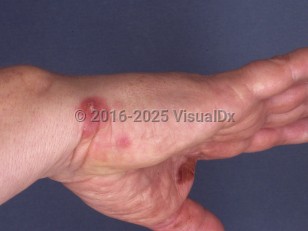Sponge dermatitis
Alerts and Notices
Important News & Links
Synopsis

Sponges (Porifera) are primitive, multicellular, sedentary marine creatures found attached to surfaces throughout the world, from the tropics to the polar regions, and from intertidal zones to great depths. Sponges have a horny but elastic skeleton with embedded spicules of calcium carbonate or silica that are used for structure and defense. Some species of sponges have small perforations from which crinotoxins are released, and some sponge species may be colonized by other sponges, sea anemones, or other small marine creatures.
Contact with a sponge may cause a contact (allergic) dermatitis or an irritant dermatitis. Contact dermatitis may result from contact with the sponge's crinotoxins, toxins associated with the colonizing animals, or some yet unidentified dermatotoxin. Irritant dermatitis is caused by sponge spicules embedded in the skin.
Contact sponge dermatitis is an allergic reaction that often begins 5 minutes to 2 hours after contact with a sponge and is typically seen on the hand. A stinging, itching, or burning sensation is felt and is usually aggravated by wetting or rubbing the area. Edema, warmth, and joint stiffness may be the only signs or a red urticarial rash may develop. Without treatment, symptoms last for 3-7 days. Typically, there are no systemic symptoms unless a large area of skin came into contact with a sponge. Fever, chills, nausea, malaise, muscle cramps, and dizziness have been reported. Erythema multiforme and an anaphylactoid reaction may develop 1-2 weeks after a severe exposure.
Irritant dermatitis, caused by sponge spicules of calcium carbonate or silica, is difficult to distinguish from contact dermatitis. Therefore, treatment addresses both skin diseases.
Contact with a sponge may cause a contact (allergic) dermatitis or an irritant dermatitis. Contact dermatitis may result from contact with the sponge's crinotoxins, toxins associated with the colonizing animals, or some yet unidentified dermatotoxin. Irritant dermatitis is caused by sponge spicules embedded in the skin.
Contact sponge dermatitis is an allergic reaction that often begins 5 minutes to 2 hours after contact with a sponge and is typically seen on the hand. A stinging, itching, or burning sensation is felt and is usually aggravated by wetting or rubbing the area. Edema, warmth, and joint stiffness may be the only signs or a red urticarial rash may develop. Without treatment, symptoms last for 3-7 days. Typically, there are no systemic symptoms unless a large area of skin came into contact with a sponge. Fever, chills, nausea, malaise, muscle cramps, and dizziness have been reported. Erythema multiforme and an anaphylactoid reaction may develop 1-2 weeks after a severe exposure.
Irritant dermatitis, caused by sponge spicules of calcium carbonate or silica, is difficult to distinguish from contact dermatitis. Therefore, treatment addresses both skin diseases.
Codes
ICD10CM:
T63.631A – Toxic effect of contact with sea anemone, accidental, initial encounter
SNOMEDCT:
403159009 – Sponge dermatitis
T63.631A – Toxic effect of contact with sea anemone, accidental, initial encounter
SNOMEDCT:
403159009 – Sponge dermatitis
Look For
Subscription Required
Diagnostic Pearls
Subscription Required
Differential Diagnosis & Pitfalls

To perform a comparison, select diagnoses from the classic differential
Subscription Required
Best Tests
Subscription Required
Management Pearls
Subscription Required
Therapy
Subscription Required
References
Subscription Required
Last Updated:05/26/2020
Sponge dermatitis

